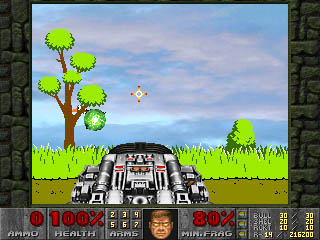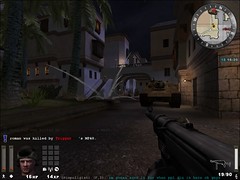While the part I had in making it was minor, it still looks pretty cool: The Outfit game trailer.
Duck Doom
Check out this mash-up of the classic Duck Hunt with another classic, Doom.

“The objective is simple. Shoot as many ducks as you can with Doom weapons such as The Super Shotgun, The Chaingun, The Rocket Launcher and The BFG-900!”
Personally I find the regular shotgun to be the most reliable. Total retro awesomeness: Duck Doom.
(via BoingBoing)
Nintendo Revolution
Nintendo has released a teaser video of their new system and wild new controller. Danc from lostgarden.com offers a scholarly essay on Nintendo’s genre innovation strategy.

At first I thought the controller looked ridiculous and thought it would be a tremendous flop, however Danc’s article has made me reconsider. His article doesn’t focus on the new system itself and it is a bit long, but if you’re curious about why Nintendo would invest so heavily in an untested market, it’s worth the read.
I hope we talk about this in my Theory and Aesthetics of Video Games class.
Return to Castle Wolfenstein: Enemy Territory – How to change nick color
 This is probably pretty boring to %99.9 of the people that read this, but for the other 0.1% here is something I learned about while playing Wolfenstein Enemy Territory (download) this afternoon.
This is probably pretty boring to %99.9 of the people that read this, but for the other 0.1% here is something I learned about while playing Wolfenstein Enemy Territory (download) this afternoon.
You can change the colour of the text in your nick name by adding a ^ and then a number in front of the text you want to change. Each number from 0 to 9 is a different color.
- ^0 = Black
- ^1 = Red
- ^2 = Green
- ^3 = Yellow
- ^4 = Blue
- ^5 = Light Blue
- ^6 = Violet
- ^7 = White
- ^8 = Orange
- ^9 = Grey
Here is a site that lets you preview nick colors.
I also learned recently that as a medic you can stick the other team with your needle and poison them. When someone is poisoned, their screen turns up side down and their health slowly goes down. They also make a choking sound — it’s my favorite thing to do in the game.
Helvetica Vs. Arial
As a fan of both typefaces and silly time wasting flash games, I feel a certain responsibility to show you Helvetica Vs. Arial.
Flash Game
Hey, look who they made a game about.
The Game of World Domination
Last night I played Risk with Amos, Gavin, and a couple of other guys I hardly know. The thing about Risk is that probability is a major aspect of the game (hence the name). I’m not kidding anybody when I say I never really understood how to properly calculate probability, but a few years ago I became terribly curious about the odds of winning a battle in Risk. I created a small program that generated random numbers and then averaged out the wins and losses finding out the best numbers to have when attacking, defending, and whether to defend with one or two dice. Needless to say it was very inefficient.
Anyway the point is that last night is the first time I’ve played Risk since making the program. I put my strategy into action since learning how substantially more effective it is to put at least two or three pieces on each territory and worry more about defense than offence. When it came to the game last night it’s true that I didn’t control any continents until the very end, but when I began to attack, I dominated the whole world. For the Risk players out there, rather than make your own program (like I did) here is a better way (not mine) to calculate odds of winning: the Risk Calculator.
Tribes 1 and 2 released for free download
Since I am hooked on Tribes 2, I have to point out that Tribes 1 and 2 are now available for download. See Slashdot Games for more details.
Mental Chinook 3D Driving Game
It’s finally done. Mental Chinook is 3D driving game made in Macromedia Director for my production management class.
Unfortunately, it looks like the actual game file is lost. I thought I had a backup somewhere but I can’t find it.
Grow
Grow weird things on a weird planet… weirdly.